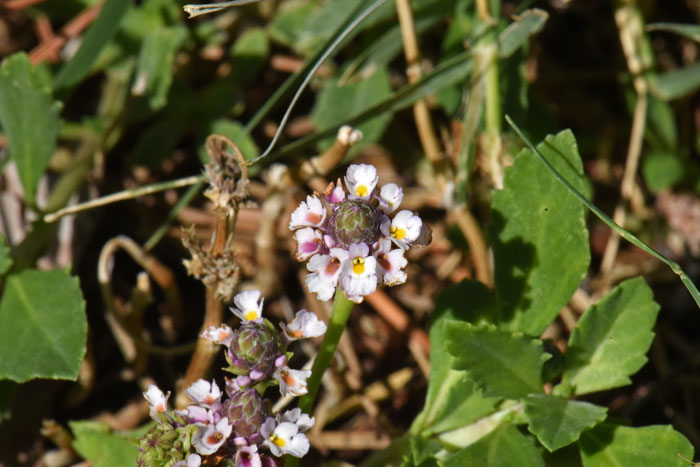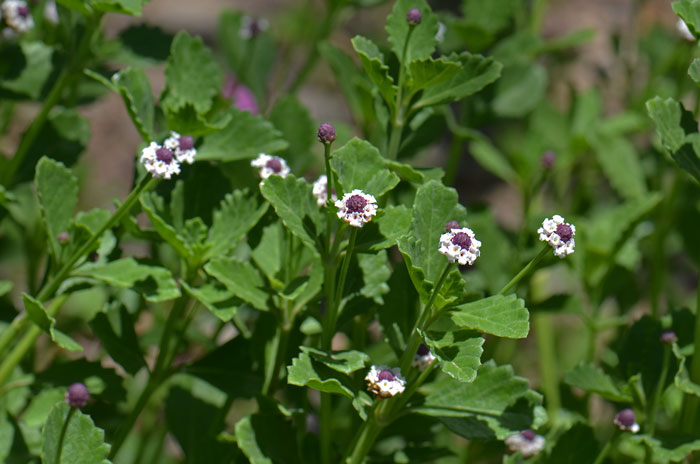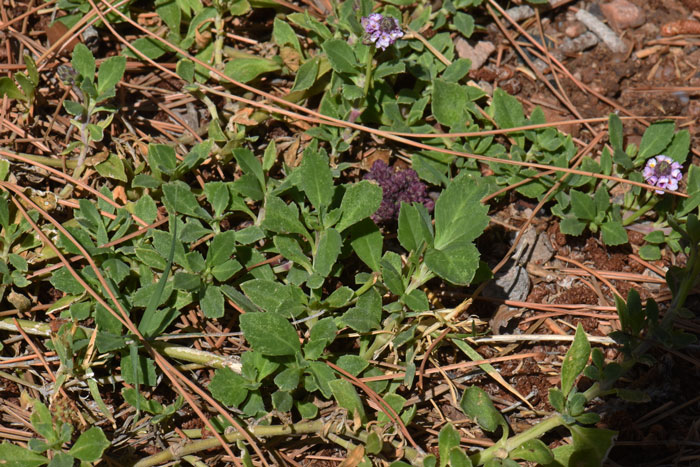Phyla nodiflora, Turkey Tangle Fogfruit



Scientific Name: Phyla nodiflora
Common Name: Turkey Tangle Fogfruit
Also Called: Frogfruit, Frog Fruit, Sawtooth Fogfruit, Texas Frogfruit, Turkey Tangle
Family: Verbenaceae, Verbena or Vervain Family
Synonyms: (Lippia canescens, Lippia incisa, Lippia nodiflora, Lippia nodiflora var. acutifolia, Lippia nodiflora var. canescens, Lippia nodiflora var. reptans, Lippia nodiflora var. rosea, Lippia reptans, Phyla incisa, Phyla nodiflora var. antillana, Phyla nodiflora var. canescens, Phyla nodiflora var. incisa, Phyla nodiflora var. longifolia, Phyla nodiflora var. nodiflora, Phyla nodiflora var. repens, Phyla nodiflora var. reptans, Phyla nodiflora var. rosea, Phyla nodiflora var. texensis)
Status: Native
Duration: Perennial
Size: Up to 15 inches or more.
Growth Form: Forb/herb; plants not aromatic; stems about 6 inches, procumbent, visible inter-nodes.
Leaves: Green, reddish or purplish ting in cold winters; strigose; rhombic-obovate, oblanceolate, widest above the middle, seldom toothed below the middle.
Flower Color: White, pink to reddish; inflorescence a peduncle; calyx lobes shorter than the tube.
Flowering Season: May to October in Texas.
Elevation: Below 1,500 feet.
Habitat Preferences: Generally riparian, wet areas including ditches, roadways, beaches and fields in Texas.
Recorded Range: Phyla nodiflora is found throughout the southern ½ of the United States. AL, AR, AZ, CA, FL, GA, HI, KS, KY, LA, MD, MO, MS, NC, NM, NV, OK, OR, PA, SC, TX, UT, VA. It is also found in Baja California, north and central Mexico south to South America.
In Arizona it is found in the central (Maricopa and Gila counties), southern (Cochise, Pima, Santa Cruz counties), southwest in Yuma County and northeast in Apache County.
North America & US County Distribution Map for Phyla nodiflora.
U.S. Weed Information: No information available.
Invasive/Noxious Weed Information: No information available.
Wetland Indicator: In North America Phyla nodiflora has the following wetland designations: Arid West, FACW; Atlantic and Gulf Coastal Plain, FAC; Eastern Mountains and Piedmont, FACW; Great Plains, FAC; Midwest, FACW; Western Mountains, Valleys, and Coast, FAC.
FACW = Facultative Wetland, usually occur in wetlands, but may occur in non-wetlands
FAC = Facultative, occur in wetlands and non-wetlands.
Threatened/Endangered Information: No information available.
In the Southwestern United States: Arizona, New Mexico and Utah each have 3 species of Phyla, California and Texas have 4 species and Nevada has 2 species. All data is approximate and subject to taxonomic changes.
Comments: Phyla nodiflora may be a native species but can readily become a weedy pest in lawns. Because it spreads quickly through above-ground rootings, and stays green without a hard freeze, it has been cultivated as a alternative ground-cover with decent results.
Turkey Tangle Fogfruit has flowers with ample nectar that are visited regularly by bees and other insects. BAMONA; Butterflies and Moths of North America: reports that Lippia is a host plant for the Phaon Crescent Butterfly, (Phyciodes phaon) and for the White Peacock Butterfly, (Anartia jatrophae). Both species deposit eggs on the host plants and the caterpillars feed on the leaves.
Phyla nodiflora has been used for food and traded by North American indigenous peoples.
Houma Drug, Orthopedic Aid, Decoction of plant used as a wash to make weak, lazy babies walk.
See ethno-botanical uses at Native American Ethnobotany, University of Michigan, Dearborn.

